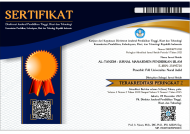Achsani, H., Kustono, D., & Suhartadi, S. (2020). Model Kelas Industri pada Mitsubishi School Program di Sekolah Menengah Kejuruan. Jurnal Pendidikan: Teori, Penelitian, Dan Pengembangan, 5(8), 1078. https://doi.org/10.17977/jptpp.v5i8.13878
Asyuyuti, I. B., Sudana, I. M., & Kuswardinah, A. (2022). Development of Industrial Culture Learning Module to Improve Student's Soft Skill at SMK Muhammadiyah 2 Kuningan. Journal of Vocational and Career Education, 7(1). https://doi.org/10.15294/JVCE.V6I2.34965
Atmawati, A., Samsudi, S., & Sudana, I. M. (2017). Keefektifan Pelaksanaan Praktik Kerja Lapangan Berbasis Industri pada Kompetensi Keahlian Teknik Audio Video. Journal of Vocational and Career Education, 2(2), 1–8.
Ayaz, A., & Karacan Özdemir, N. (2023). A case study of a Turkish vocational high school, and the challenges for teachers. Journal of Vocational Education & Training, 75(3), 459–478. https://doi.org/10.1080/13636820.2021.1895873
Ayu, E. F., & Trihantoyo, S. (2021). Optimalisasi Bursa Kerja Khusus dalam Menyalurkan Lulusan SMK pada Dunia Usaha/Dunia Industri (DU/DI) | Inspirasi Manajemen Pendidikan. Jurnal Inspirasi Manajemen Pendidikan, 9(4), 932–941.
Azman, A., Simatupang, W., Karudin, A., & Dakhi, O. (2020). Link and match policy in vocational education to address the problem of unemployment. International Journal of Multi Science, 1(7), 6–86.
Cahyanti, S. D., Indriayu, M., & Sudarno, S. (2018). Implementasi Program Link and Match dengan Dunia Usaha dan Dunia Industri pada Lulusan Pemasaran SMK Negeri 1 Surakarta. BISE: Jurnal Pendidikan Bisnis Dan Ekonomi, 4(1), 16–37.
Caleb, M., Chopra, S., & Burns, M. C. (2017). A Meta-analysis of the Effect of Industry Engagement on Student Learning in Undergraduate Programs. The Journal of Technology, Management, and Applied Engineering, 33(1).
Dami, Z. A. (2021). Informal teacher leadership: lessons from shepherd leadership. International Journal of Leadership in Education. https://doi.org/10.1080/13603124.2021.1884749
Jayanti, G., Achmadi, A., & Okianna, O. (2020). Relevansi program keahlian lulusan SMA dengan dunia kerja di kota Pontianak. Jurnal Pendidikan Dan Pembelajaran Khatulistiwa (JPPK), 9(10), 1–9. https://doi.org/10.26418/JPPK.V9I10.42963
Korber, M. (2019). Does vocational education give a labour market advantage over the whole career? A comparison of the United Kingdom and Swit. Social Inclusion, 7(3), 202–223. https://doi.org/10.17645/si.v7i3.2030
Mahmudah, F. N., & Santosa, B. (2021). Vocational School Alignment Based-on Industry Needs. Journal of Vocational Education Studies, 4(1), 36–45. https://doi.org/10.12928/JOVES.V4I1.3611
Mulyanto, & Widodo, E. N. (2023). Absorption Rate of Industrial Program Vocational High School Students to the World of Work. Journal for Lesson and Learning Studies, 6(2), 341–351. https://doi.org/10.23887/jlls.v6i2.60000
Mutaqin, M. K. A., Kuswana, W. S., & Sriyono, S. (2015). Studi eksplorasi keterserapan lulusan sekolah menengah kejuruan negeri di kota Bandung pada industri otomotif. Journal of Mechanical Engineering Education (Jurnal Pendidikan Teknik Mesin), 2(2), 247–252. https://doi.org/10.17509/JMEE.V2I2.1486
Nugroho, W. (2022). Integration of Character Education in Vocational Education in Vocational High Schools. Vocational: Journal of Vocational Education Innovation, 2(1), 73–84. https://doi.org/10.51878/vocational.v2i1.936
Nurcahyono, B., Retnowati, R., Sutisna SMK Negeri, E., & Bogor, K. (2020). Implementasi kurikulum berbasis industri di SMK mitra industri MM2100 Cikarang – Bekasi. Jurnal Manajemen Pendidikan, 8(2), 81–88. https://doi.org/10.33751/JMP.V8I2.2760
Özer, M., & Suna, H. E. (2020). Türkiye’de Mesleki ve Teknik Eğitim ile İş Piyasası Arasındaki Bağlantı: İstihdam ve Beceri Uyuşmazlığı. Kastamonu Eğitim Dergisi, 28(2), 558–569. https://doi.org/10.24106/kefdergi.704878
Pearce, J., & Robinson, R. (2011). Manajemen Strategik. Binapura Kasara Publisher.
Prasetyo, Y. D., Tiwan, T., & Soemowidagdo, A. L. (2018). Pengaruh Praktik Industri Terhadap Hard Skill Siswa SMK pada Program Keahlian Teknik Pemesinan. Jurnal Dinamika Vokasional Teknik Mesin, 3(2), 87–93. https://doi.org/10.21831/DINAMIKA.V3I2.21404
Pratama, P., & Bintang, S. (2017). Penerapan Strategi Pembelajaran Pelatihan Industri (Training Within Industry) Terhadap Aktivitas dan Hasil Belajar Instalasi Motor Listrik. Jurnal Pendidikan Teknologi Dan Kejuruan, 17(2), 73–79.
Rachmawati, A.D., & Kusumah, Y. S. (2023). Evaluation of industrial work practice program in Vocational High School 1 Rejotangan. Jurnal Pendidikan Vokasi, 13(1), 60–68. https://doi.org/10.21831/jpv.v13i1.46917
Rakhman, M. L., & Trihantoyo, S. (2020). Peran Hubungan Masyarakat Era Marketting 4.0 Dalam Meningkatkan Keterserapan Lulusan Program Keahlian Multimedia di SMK Negeri 12 Surabaya. Jurnal Inspirasi Manajemen Pendidikan Volume, 8(3), 199–212.
Ripamonti, E. (2023). School-to-work transition: putting non-cognitive skills in context. The case of NEET and suggestions for policy. International Journal for Educational and Vocational Guidance, 1–22. https://doi.org/10.1007/S10775-023-09635-6/FIGURES/1
Rizki, N. A., Suyadi, B., & Sedyati, R. N. (2018). Pengaruh praktik kerja industri terhadap kemampuan penguasaan hardskill siswa kelas XI program keahliaan teknik computer dan jaringan SMA negeri 5 Jember tahun ajaran 2016/2017. Jurnal Pendidikan Ekonomi: Jurnal Ilmiah Ilmu Pendidikan, Ilmu Ekonomi dan Ilmu Sosial, 11(2), 89–95. https://doi.org/10.19184/JPE.V11I2.6452
Rojaki, M., Fitria, H., & Martha, A. (2021). Manajemen Kerja Sama Sekolah Menengah Kejuruan dengan Dunia Usaha dan Dunia Industri. Jurnal Pendidikan Tambusai, 5(3), 6337–6349. https://doi.org/10.31004/JPTAM.V5I3.1949
Safitri, E. R., Nurlaela, L., Rijanto, T., & Munoto, M. (2020). Analysis of Industrial Practice Activities In Vocational Schools In Facing Industrial Revolution 4.0. International Journal for Educational and Vocational Studies, 2(5). https://doi.org/10.29103/IJEVS.V2I5.2472
Saldaña, J. (2016). The coding manual for qualitative researchers. Sage.
Santi, T.D., & Faridah, A. (2021). Validity of Moodle-Based Mobile Learning Development at Aisyiyah Tourism Vocational High School on Food Ingredient Knowledge Subjects. Cakrawala: Journal of Education, 15(1), 18–27. https://doi.org/10.24905/cakrawala.v15i1.263
Santika, E. F. (2023). Pengangguran Terbuka Lebih Banyak Berasal dari Lulusan Sekolah Menengah dan Kejuruan. https://databoks.katadata.co.id/datapublish/2023/06/21/pengangguran-terbuka-lebih-banyak-berasal-dari-lulusan-sekolah-menengah-dan-kejuruan
Suroto, S. (2017). Model perencanaan sekolah menengah kejuruan penyelenggara kelas standar industri. Jurnal Taman Vokasi, 5(2), 204–211. https://doi.org/10.30738/JTV.V5I2.2524
Syarifuddin, A., Pristanti, H., & Lucas, J. (2020). Identifikasi Keterserapan Lulusan Jurusan Administrasi Bisnis Politeknik Negeri Samarinda. E-BISMARK : Jurnal Ekonomi, Bisnis Dan Marketing, 1(1), 17–23. https://doi.org/10.46964/jebm.v1i1.356
Tan, O. S., Jia, J., & Chua, E. (2023). Singapore’s Endemic Approach to Education: Re-Envisioning Schools and Learning. Schools and Society During the COVID-19 Pandemic, 193–210. https://doi.org/10.1007/978-3-031-42671-1_10
Triwahyudi, J. (2020). Manajemen Kemitraan Sekolah dan Dunia Industri Dalam Penyerapan Lulusan SMK. Media Manajemen Pendidikan, 3(1), 88–99. https://doi.org/10.30738/MMP.V3I1.4323
Wheelen, T. L., & Hunger, J. D. (2010). Strategic Management and Business Policy Achieving Sustainability. Pearson.
Yin, R. K. (2018). Case Study Research and Applications: Design and Methods (6th ed.). Sage.
 (Universitas Persatuan Guru 1945 NTT)
(Universitas Persatuan Guru 1945 NTT) 







